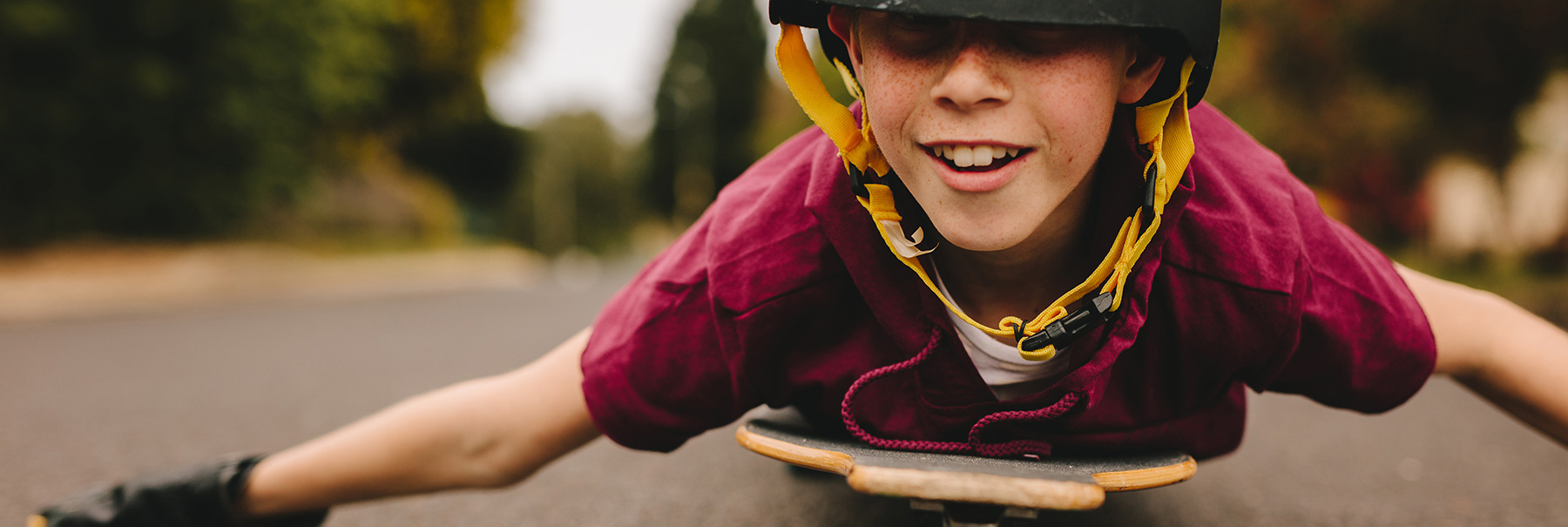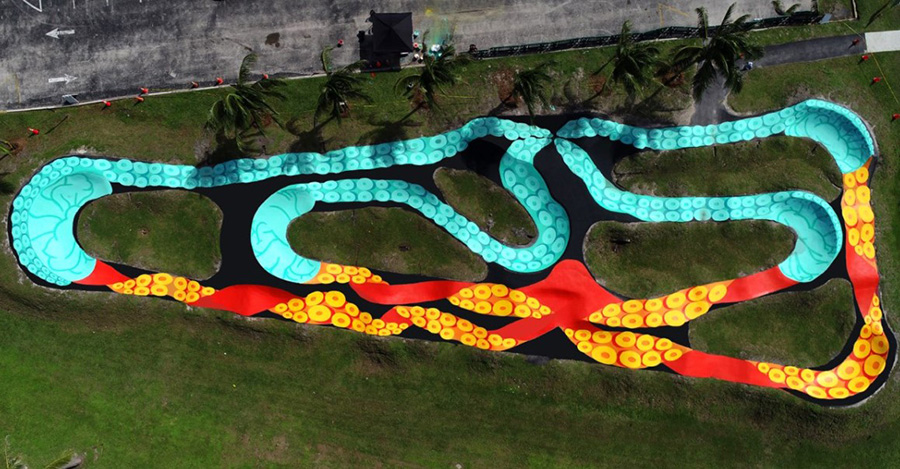Helmets for Skateboarders are a No-Brainer

Skateboarding is an exciting sport that attracts daredevils, young and old, with a rebellious spirit. It can be a fun form of exercise and a great way to encourage kids to get outside and stop looking at their phones. On the flip side, skateboarding without proper safety measures can lead to far more than scraped knees.
Serious accidents often involve the brain, neck, and spinal cord. In fact, 20% of all skateboarding injuries are to the head, and a higher proportion of them involve skaters under 10 years old.
Is skateboarding dangerous?
Skateboarding can lead to brain injuries similar to those associated with other popular sports like football, soccer, and cheerleading. Only about 5% of skateboarding injuries are severe. But, skater culture encourages risk-taking. Often unsupervised, young skaters try to one-up and impress each other with increasingly more challenging tricks. Even epic fails caught on video can go viral.
The competitive nature of skateboarding may serve as a roadblock with hardheaded teens. Still, convincing skaters of all ages to wear the right protective gear and use good judgment can make all the difference.
“I see little kids under age 10 with their helmets on. But teenagers and young adults in their 20s often aren’t wearing them,” says Gillian Hotz, Ph.D., a neuroscientist and Director of the Concussion Program at the University of Miami Health System who specializes in concussion, neurotrauma, neurocognition, and neurorehabilitation.
“‘Why no helmet?’ I ask them. ‘I’m going to be fine!’ they tell me. I don’t care how skilled you are; put a lid on it because you may wipe out. Older kids who skateboard can set an example for the little kids. Their brains are just as susceptible to injury,” Dr. Hotz says.
Falls are going to happen.
Skateboarding falls cause skin abrasions, bruises, sprains, strains, wrist fractures, long bone fractures, and broken noses and jawbones. But, hitting the head on pavement, steps, or a handrail can lead to more severe injuries. These include concussions, skull fractures, and traumatic brain injuries. This kind of trauma to the central nervous system (which includes the brain) can have life-altering effects.
While concussions may appear mild, see a doctor immediately to address any of the following issues after an accident involving the head or neck:
- dizziness
- nausea
- disorientation/walking in the wrong direction
- loss of consciousness/fainting
- loss of balance
- headache
- sudden fatigue/sleepiness
- confusion/disorientation
- vision issues
- sensitivity to light
- slurred speech
- seizure/shaking
- difficulty breathing
- mental fogginess/confusion
- difficulty concentrating
- seeming “off” or acting oddly
If a mild brain injury goes ignored and the skater gets right back on their board, a second impact to the head or neck could be life-threatening. “Err on the side of going to the ER,” Dr. Hotz says. “With precious developing brains, if something is going on, we want to address it early. If there’s some blood in the brain, it needs to be evaluated.”
Gear up to protect your brain and your bones.
Helmets are a must
Do not let your child ride a skateboard without a helmet. Not all helmets are designed for the risks of skateboarding. The Centers for Disease Control and Prevention provides specific guidelines for finding the right fit.
Don’t forget bodily protection
Skateboarders should wear these every time they grab their board to get from point A to point B, not only when heading out to a skate park.
- wrist guards
- knee and elbow pads
- closed-toe shoes with non-slip soles
Common-sense guidelines to avoid dangerous skating situations
- Don’t let children under age 5 use a skateboard.
- Check your board’s wheels.
- Practice and perform tricks in a designated skate park. They offer wide, smooth, level surfaces.
- If you don’t have a skate park nearby, tell kids to skateboard on the sidewalk at all times, not in the street with vehicles and bicyclists.
- Don’t ride over potholes/uneven pavement or through crowds of people.
- Don’t skate on rainy days or just after it has rained.
Seeking a cure for paralysis

The KIDZ Neuroscience Center at UHealth’s Miami Project to Cure Paralysis partnered with Miami-Dade Parks, Recreation, and Open Spaces in an effort to prevent and reduce brain injuries among local skateboarders. The result is Haulover Beach Skate Park and Pump Track’s new design featuring an octopus with safety messaging. As skateboarders and other athletes enjoy the park, the eye-catching design reminds them of the basics of injury prevention.
“Painting the park was, in part, my brainchild,” Dr. Hotz says. “I pass this skate park every day, and it makes me nuts to see the kids without helmets. My colleagues and I thought that educational messaging delivered through street art might resonate. We found local urban artist Rey Jaffet, Jr., who coincidentally was a patient of mine years ago with multiple concussions when he played football. He created this great design.”
Dr. Hotz and her colleagues have extended this educational messaging to other skate parks in Miami-Dade, including a skate guard program with certified skateboarding guards who serve as lifeguards at public swimming pools.
Through groundbreaking research and clinical trials, experts at UHealth and The Miami Project focus on:
- understanding what happens after central nervous system injury
- protecting the injured brain and spinal cord from further damage
- replacing dead nervous system cells (neurons and glia)
- promoting and guiding axon growth
- reestablishing essential circuitry
- preventing and treating complications
- maintaining the maximum potential for recovery
- translating findings from laboratory research to clinical trials
“At UHealth, we’re using novel ways to observe the brain beyond standard MRIs and CT scans,” Dr. Hotz says. These include neuroimaging studies with functional MRIs, diffusion tensor imaging, biomarker studies, and EEG studies using handheld devices the size of a cell phone. UHealth also uses special goggles to examine eye movement in concussed patients experiencing vestibular issues.
“I’m also interested in seeing more research on the possibilities of using CBD (the non-psychoactive agent in cannabis) for symptom relief for brain injury patients,” says Dr. Hotz. She reports that animal studies have optimistic findings. “Of course, we need human clinical trials and should develop regulations for producing and prescribing medicinal CBD for this purpose.”
While doctors like Hotz help neurotrauma patients recover from brain injuries, the bottom line is “prevention needs more attention,” as she says.
“Now that skateboarding is an Olympic sport, you’re hopefully going to see those elite athletes wearing cool helmets. It’s so important that younger skaters see this and learn from a young age that wearing a helmet is just part of the sport; it’s what they should do.”
Dana Kantrowitz is a contributing writer for UMiami Health News.
Originally published on: November 30, 2020
Tags: brain injury, Dr. Gillian Hotz, sports innjury, TBI, UHealth Concussion Program
